This review is a preview of a more formal review which will appear a few months from now in the Journal of Sex and Marital Therapy. I will start by putting this book into context and then I will address the content before going into other aspects of the book, such as structure, quality of writing, etc. The author, Neil Strauss is a Rolling Stone Magazine journalist, and known for co-authoring books by rock stars such as Marilyn Manson, Dave Navarro from Jane’s Addiction, and Motley Crue. These names will all be familiar to those who were into rock music in the late 80s through the 90s. He then came to more prominence by documenting his rise from a journalist nerd who couldn’t “score” even when traveling with rock stars to a guy who learned to “pick up” women in the The Game. The Truth is marketed as a sequel in which this ladies’ man is now trying to learn how to maintain a great relationship now that he can find willing partners to form one. I happened to get my hands on a copy after a social media discussion I had with the author, in which I stated I was willing to provide an honest review in exchange for a copy of the book.
While The Game has received criticism for its portrayal of attitudes towards women within the “seduction community”, as it is called, I found The Truth to have more broad appeal to a variety of different groups. Off the top of my head, the following individuals would probably find at least something of interest within this book: Individuals who are struggling with infidelity; those who are wondering about or contemplating diagnosing themselves as sex addicts or entering sex addiction treatment; folks who are exploring opening up their relationship; those who are curious about the differences between tantra, polyamory, swinging, and other forms of consensual nonmonogamy; and those individuals who are seeking a multitude of theories and perspectives on human mating and pair bonding. In other words, this book is highly appropriate for most therapists, especially those working with couples, relationships, and human sexuality, as well as the clients of those therapists. Perhaps, this is one reason I found The Truth to be so engaging.
Right away, we learn that Strauss has been caught cheating on his girlfriend, and in an effort to understand his own behavior, he checks himself into a sex addiction rehab clinic. His descriptions of his experiences are emotionally intense and harrowing, as he struggles with the confusion he experiences between his previous attitudes about sex and the addiction model he is exposed to in rehab. As readers of this blog know, I have been a long-time critic of the sex addiction model, so for me this segment of the book was of particular interest. Needless to say, many of Strauss’ experiences were disturbing, but unfortunately not entirely surprising to me, based on what I’ve heard from others who have stayed an inpatient sex addiction facility. Here are a few examples of the kind of nonsense Strauss was exposed to:
- When he comes in, a nurse informs him “… if you’re visiting porn sites, or if you’re masturbating, that’s sex addiction.” p. 15
- A guy in his group therapy said he slept with a “hot girl”, the counselor says “As a therapist, when I hear the word girl, I have to automatically assume that you’re talking about a minor. And I’m obliged to report that.” p. 29
- The therapist informs Strauss he must abstain from all sexual conduct for twelve weeks. That is because, “It takes three months for your brain to return to normal after all the imbalances caused by the constant high of sex.” p. 31
- The same therapist tells Strauss that “Are you aware that undressing someone with your eyes is covert sexualized violence?” p. 36
- A male pt confesses to being attracted to a female pt, the therapist ask, “Go ahead, tell everyone how you pornified her.” p. 36
- Strauss was talking to a female pt during lunch time, another pt ratted on him to the counselor. The counselor asked Strauss, “Do you see women as human beings or do you see them as a collection of body parts?” p. 46
- Strauss confides that his father has a unique fetish, the therapist tells him, “Are you aware that sex addiction has a genetic component?”
There are many more examples, but I think these suffice to provide a sense of Strauss’ experience. He does do some good “chair work” but then leaves prematurely to return home to his girlfriend, still grappling with all of the pathological labels that have been heaped upon him. At this point, he decides to explore the complete opposite end of the spectrum, and the world of free love, casual sex, and consensually nonmonogamous relationship structures of all stripes. I found this section of the book to be particularly amusing, as his descriptions of the characters he encounters and the bumbling mistakes he makes often are hilarious. In addition, what separates Strauss apart from other authors who have written on these subjects is his level of introspection and self-awareness, but especially his razor sharp psychological insight.
As an example, he starts out by consulting with a New Age polyamory guru who beckons him to sit on her bed. Strauss writes, “I wonder what kind of woman would let a stranger, who contacted her off the Internet, into her home and onto her bed within seconds. Then I realized that’s exactly the kind of woman I’ve come here looking for (p.165).” He then explores the world of tantra at the World Polyamory Association Conference, in which a bunch of new-hippies gather together in a clothing optional resort for some naked touch and rolling around.
He is not feeling the vibe, so he separates himself and observes from a far wall, munching on popcorn. At this point Strauss realizes, “… I get what this is all about… There’s a disparity between the masculine desire for sex, which tends to be carnal and ego based, and the feminine desire for sex, which can be more emotional and spiritual. So if swinging is for horny men, then this scene is for sensual women (p.183.)” Strauss ends up being kicked out for eating popcorn and bothering the group with his bad vibes. Shortly after, he meets an expert who confirms, “Because of all the immoral connotations of sex, they make it into something divine and polite instead of physical and passionate. I think this is because a lot of the gurus know that most women need an emotional connection to have sex, and spirituality is the quickest, deepest way there (p.185).” I’m providing these quotes as an example of the level of psychological insight and emotional transparency that is prevalent throughout this book.
Strauss then gets involved with some shady swingers, who take him through a drug-fueled night of orgies in Las Vegas. Here again, Strauss’ perceptiveness cuts through the scene like a knife, as he analyzes the motivations of the men in the swinger scene, “I always thought that, for men, the Lifestyle was about fucking other women. But… it’s also about showing off the woman they love: Look what I’ve got. And she loves me, so I must have value. And if you treat me with enough respect and admiration, I will share her with you– but not too much, because I don’t want to lose control of her. That would cause me to feel pain and question my fragile sense of worth (p. 219–220).” He concludes, “Swapping is the ultimate in male bonding (p.220).”
Strauss then tries to create a pod consisting of himself and three other women, but things quickly fall apart, as he makes every newbie mistake in the book, and loses control of the situation. He tries to understand why he cannot pull off a harem like the man he has been trying to emulate, Father Yod, a commune leader in the 1970s who had eleven wives. Strauss interviews one of Yod’s former wives and begins to “understand that what it takes to enjoy being the fulcrum is a high degree of narcissism and an unwavering certainty that your needs and beliefs are more important and enlightened than those of the rest of your community– and quite possibly the world (p.286-7).” Really, all of the communes from the past were run by narcissists with strict rules, a type of life that Strauss realizes is anathema to his values.
Strauss has many other adventures, in which he is attacked by a jealous boyfriend with an axe, and where one of his girlfriends runs off with some male servant types to Mexico. In the end, he is left feeling empty and alone, craving to be reunited with his first girlfriend, Ingrid, whom he cheated on at the very beginning. I’ll skip all of this, as he goes back into therapy and works on himself, reconnects with his true love, and they get married and live happily ever after. It all comes together like a Hollywood Happy Ending here, and maybe it did happen this way, but it does feel like everything is a little too neatly packaged and tied together with a red ribbon. After going through the entire spectrum of experiences and coming back to where he started, Strauss describes his “commitment today is to neither monogamy nor nonmonogamy. Those are other people’s values and dichotomies (p.419).”
Strauss is a very gifted writer with a keen sense for understanding complex psychological nuances. And he knows it. At 421 pages, some of the material is perhaps overwritten and certain sections do seem to drag. However, in other spots, The Truth is a real page turner and is both informative and entertaining for readers who have their own questions about sex and relationships, or who are simply interested in picking back up from where The Game left off and learning more about the author’s life.
In the end, Strauss’ thesis can be summed up in the epilogue as he reflects back on his journey. “There isn’t just one true and proper way to love, to relate, to bond, to touch. Any style of relationship is the right one, as long as it’s a decision made by the whole person and not the hole in the person (p. 419).” Amen.

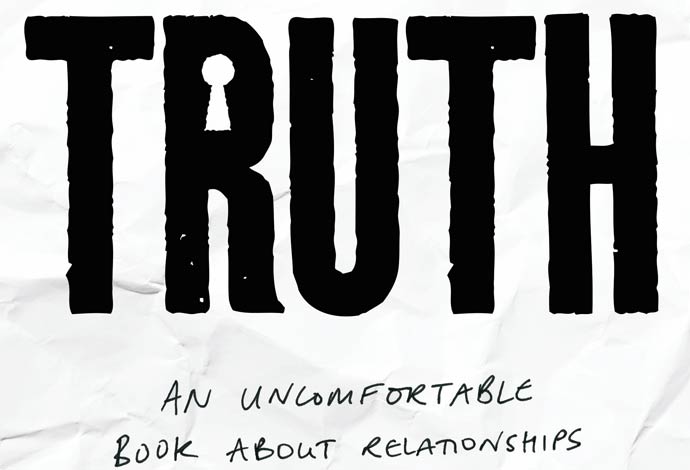
















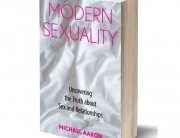

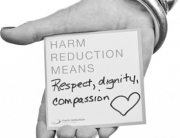
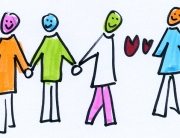
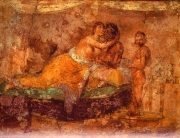






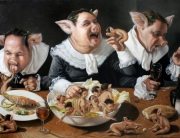



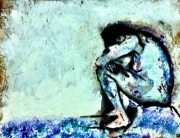

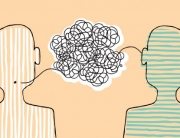




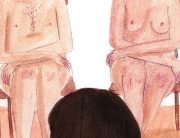















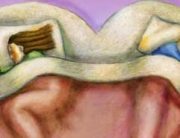
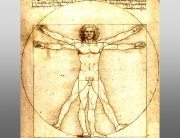














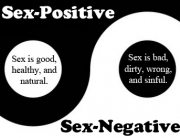
























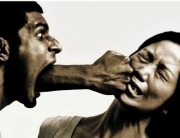


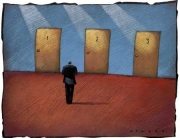








 Prevention: Is Sex Addiction Real?
Prevention: Is Sex Addiction Real? Romper: Emotional Infidelity
Romper: Emotional Infidelity Fatherly: BDSM More Common Than You Think
Fatherly: BDSM More Common Than You Think E! Online: Marrying a Murderer
E! Online: Marrying a Murderer Who Magazine: What is Bisexuality?
Who Magazine: What is Bisexuality? CNN: Why Men May Exaggerate Their Sex Numbers
CNN: Why Men May Exaggerate Their Sex Numbers Women’s Health: 10 Kinky Sex Ideas
Women’s Health: 10 Kinky Sex Ideas NY Post: How Tattoos Can Sabotage Your Love Life
NY Post: How Tattoos Can Sabotage Your Love Life Allure: 8 BDSM Sex Tips to Try If You’re a Total Beginner
Allure: 8 BDSM Sex Tips to Try If You’re a Total Beginner
 Great article in Prevention Magazine about the sex addiction controversy. Check out what I had to say.
Great article in Prevention Magazine about the sex addiction controversy. Check out what I had to say.
 Romper approached me again for another quote, this time about emotional infidelity.
Romper approached me again for another quote, this time about emotional infidelity.
 Interesting piece in Fatherly about BDSM in which I was interviewed.
https://www.fatherly.com/love-money/bdsm-kinky-sex-not-uncommon/
Interesting piece in Fatherly about BDSM in which I was interviewed.
https://www.fatherly.com/love-money/bdsm-kinky-sex-not-uncommon/ E! News picked up my an interview I did with Vice a few years ago about hybristophilia, which is the attraction to criminals. Very interesting story.
E! News picked up my an interview I did with Vice a few years ago about hybristophilia, which is the attraction to criminals. Very interesting story.
 Who is Australia's version of People Magazine. They wanted to know what bisexuality is and I provided some insight.
Who is Australia's version of People Magazine. They wanted to know what bisexuality is and I provided some insight.
 Seems like something doesn't add up on sex surveys-- are men exaggerating their number of partners? Check out what I tell CNN.
Seems like something doesn't add up on sex surveys-- are men exaggerating their number of partners? Check out what I tell CNN.
 Women's Health asked me for some kinky ideas to spice up one's sex life.
Women's Health asked me for some kinky ideas to spice up one's sex life.
 I was interviewed by the NY Post about all the ways in which I've seen bad tattoos sabotage relationships.
I was interviewed by the NY Post about all the ways in which I've seen bad tattoos sabotage relationships.
 Allure Magazine asked me about tips for BDSM beginners.
Allure Magazine asked me about tips for BDSM beginners.
 I answer questions from Salon.com about the infamous porn site PornHub.
I answer questions from Salon.com about the infamous porn site PornHub.
 I tell Cosmo about the personality traits of monogamous individuals.
I tell Cosmo about the personality traits of monogamous individuals.
 I explain to Refinery29 why it's so important to not fake orgasms in a relationship.
I explain to Refinery29 why it's so important to not fake orgasms in a relationship.
 I am interviewed in this fairly nuanced piece on the pros and cons of porn.
I am interviewed in this fairly nuanced piece on the pros and cons of porn.
 I am interviewed by Headspace, one of the best meditation and mindfulness apps available, on how to become more present.
https://www.headspace.com/blog/2017/05/26/enjoy-sex-more/
I am interviewed by Headspace, one of the best meditation and mindfulness apps available, on how to become more present.
https://www.headspace.com/blog/2017/05/26/enjoy-sex-more/ I am interviewed in this intriguing Business Insider article on how often happy couples have sex.
I am interviewed in this intriguing Business Insider article on how often happy couples have sex.
 The Huffington Post in South Africa profiles my work around challenging sex addiction (including my red/yellow/green menu exercise) .
The Huffington Post in South Africa profiles my work around challenging sex addiction (including my red/yellow/green menu exercise) .
 I go deep into the sex toy business with Vice.
I go deep into the sex toy business with Vice.
 I give some insight into this interesting topic.
https://thetab.com/us/2017/03/22/happens-boyfriend-leaves-another-man-63306
I give some insight into this interesting topic.
https://thetab.com/us/2017/03/22/happens-boyfriend-leaves-another-man-63306 I am featured in this outstanding article in UK's Independent on women and virtual reality porn. I thought this was a fairly sharp and nuanced piece.
I am featured in this outstanding article in UK's Independent on women and virtual reality porn. I thought this was a fairly sharp and nuanced piece.
 I give Redbook some pointers on having a 3some for the first time.
I give Redbook some pointers on having a 3some for the first time.

 Playboy sent a journalist to watch Fifty Shades Darker, and then compared the movie with the results from my recent groundbreaking research on BDSM. Great article, enjoy!
Playboy sent a journalist to watch Fifty Shades Darker, and then compared the movie with the results from my recent groundbreaking research on BDSM. Great article, enjoy!
 I am featured in this terrific New York Magazine article, discussing some of the finer points brought up in the earlier article in SELF magazine (see listing below).
I am featured in this terrific New York Magazine article, discussing some of the finer points brought up in the earlier article in SELF magazine (see listing below).
 I am featured in this terrific article in SELF magazine on the nuances of the sex addiction debate.
I am featured in this terrific article in SELF magazine on the nuances of the sex addiction debate.
 Complex asked me to weigh in on this provocative topic.
Complex asked me to weigh in on this provocative topic.

 I weigh in in this great advice column in Thrillist by Elle Stanger.
I weigh in in this great advice column in Thrillist by Elle Stanger.
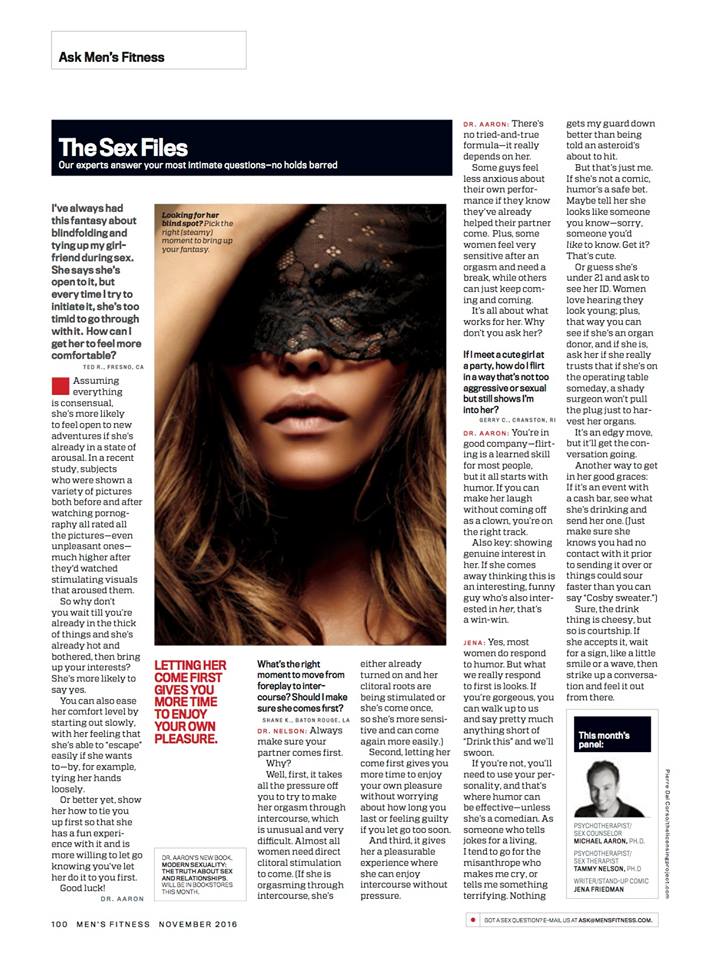
 Great episode, check it out.
https://soundcloud.com/futureofsex/04-exploring-sexual-fluidity-bicuriousity-for-women-featuring-skirt-club-and-dr-michael-aaron
Great episode, check it out.
https://soundcloud.com/futureofsex/04-exploring-sexual-fluidity-bicuriousity-for-women-featuring-skirt-club-and-dr-michael-aaron I give couples advice on how to deal with differences in preferred sleeping arrangements.
I give couples advice on how to deal with differences in preferred sleeping arrangements.
 Alternet does a great job of reviewing my book. Check out the link below.
Alternet does a great job of reviewing my book. Check out the link below.
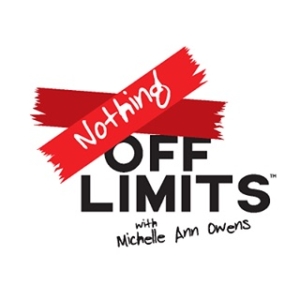 In this episode, we talk about the societal myths of sexuality, including:
In this episode, we talk about the societal myths of sexuality, including:
 I was asked to appear on Australian radio. It was a very fun segment, will post the link when I have it!
I was asked to appear on Australian radio. It was a very fun segment, will post the link when I have it! I appear on the Stereo-Typed podcast to discuss my new book, fantasies, and our shadow self. Click the audio player below and enjoy!
https://www.spreaker.com/user/crazyheart/stereo-typed-8-dancing-with-your-shadow
I appear on the Stereo-Typed podcast to discuss my new book, fantasies, and our shadow self. Click the audio player below and enjoy!
https://www.spreaker.com/user/crazyheart/stereo-typed-8-dancing-with-your-shadow I appear on the Boom Doctors Podcast to discuss my new book Modern Sexuality and my work as a sex therapist. Clink the link below to listen in.
http://theboomdoctors.com/2016/09/21/ep-132-michael-aaron-on-his-work-as-a-sex-therapist-his-new-book-modern-sexuality/
I appear on the Boom Doctors Podcast to discuss my new book Modern Sexuality and my work as a sex therapist. Clink the link below to listen in.
http://theboomdoctors.com/2016/09/21/ep-132-michael-aaron-on-his-work-as-a-sex-therapist-his-new-book-modern-sexuality/ I was asked by Nylon Magazine to weigh in on the subject of porn and what it means about the individual consumer. Pretty good non-pathologizing piece, check it out here:
I was asked by Nylon Magazine to weigh in on the subject of porn and what it means about the individual consumer. Pretty good non-pathologizing piece, check it out here:
 I was interviewed by Vocativ about a new virtual reality series entitled "Virtual Sexology," designed to provide breathing and relaxation exercises in a virtual reality format to help individuals improve sexual functioning. Will something like this prove effective? The jury is out, but check out what I had to say...
I was interviewed by Vocativ about a new virtual reality series entitled "Virtual Sexology," designed to provide breathing and relaxation exercises in a virtual reality format to help individuals improve sexual functioning. Will something like this prove effective? The jury is out, but check out what I had to say...
 I appeared on the nationally broadcasted Fusion Network Hotline show to discuss the GOP platform of porn as a "public health crisis." As part of the discussion I debate Dr. Neil Malamuth on porn and sexual violence. I thought this was a very thorough and productive half hour, which you can watch below:
I appeared on the nationally broadcasted Fusion Network Hotline show to discuss the GOP platform of porn as a "public health crisis." As part of the discussion I debate Dr. Neil Malamuth on porn and sexual violence. I thought this was a very thorough and productive half hour, which you can watch below:
 In this Huffington Post article, I advise couples to use sex menus to spice things up. Check out all the details in the link below.
In this Huffington Post article, I advise couples to use sex menus to spice things up. Check out all the details in the link below.

 I appeared on French national tv channel Canal + on the Emission Antoine tv show, discussing the psychology behind financial domination. I will post a video clip of the interview shortly.
I appeared on French national tv channel Canal + on the Emission Antoine tv show, discussing the psychology behind financial domination. I will post a video clip of the interview shortly. I was interviewed on Huffington Post's Love + Sex Podcast, which I'm told is the most downloaded sex and relationship podcast on iTunes. In this episode, I dispel the wild myths about "sex roulette" parties.
I was interviewed on Huffington Post's Love + Sex Podcast, which I'm told is the most downloaded sex and relationship podcast on iTunes. In this episode, I dispel the wild myths about "sex roulette" parties.
 I was interviewed for an upcoming online sexuality discussion series, the Sexual Reawakening Summit. It features many top sex therapists from around the country and you can access it by using this link:
I was interviewed for an upcoming online sexuality discussion series, the Sexual Reawakening Summit. It features many top sex therapists from around the country and you can access it by using this link: 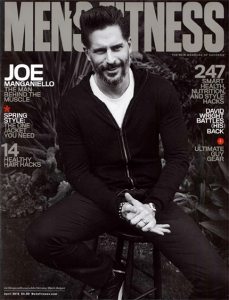 In the April edition of my Men's Fitness 'Sex Files' Q&A column, I answer questions about anal sex and porn. Hurry and pick up a copy before it's off the stands!
In the April edition of my Men's Fitness 'Sex Files' Q&A column, I answer questions about anal sex and porn. Hurry and pick up a copy before it's off the stands!
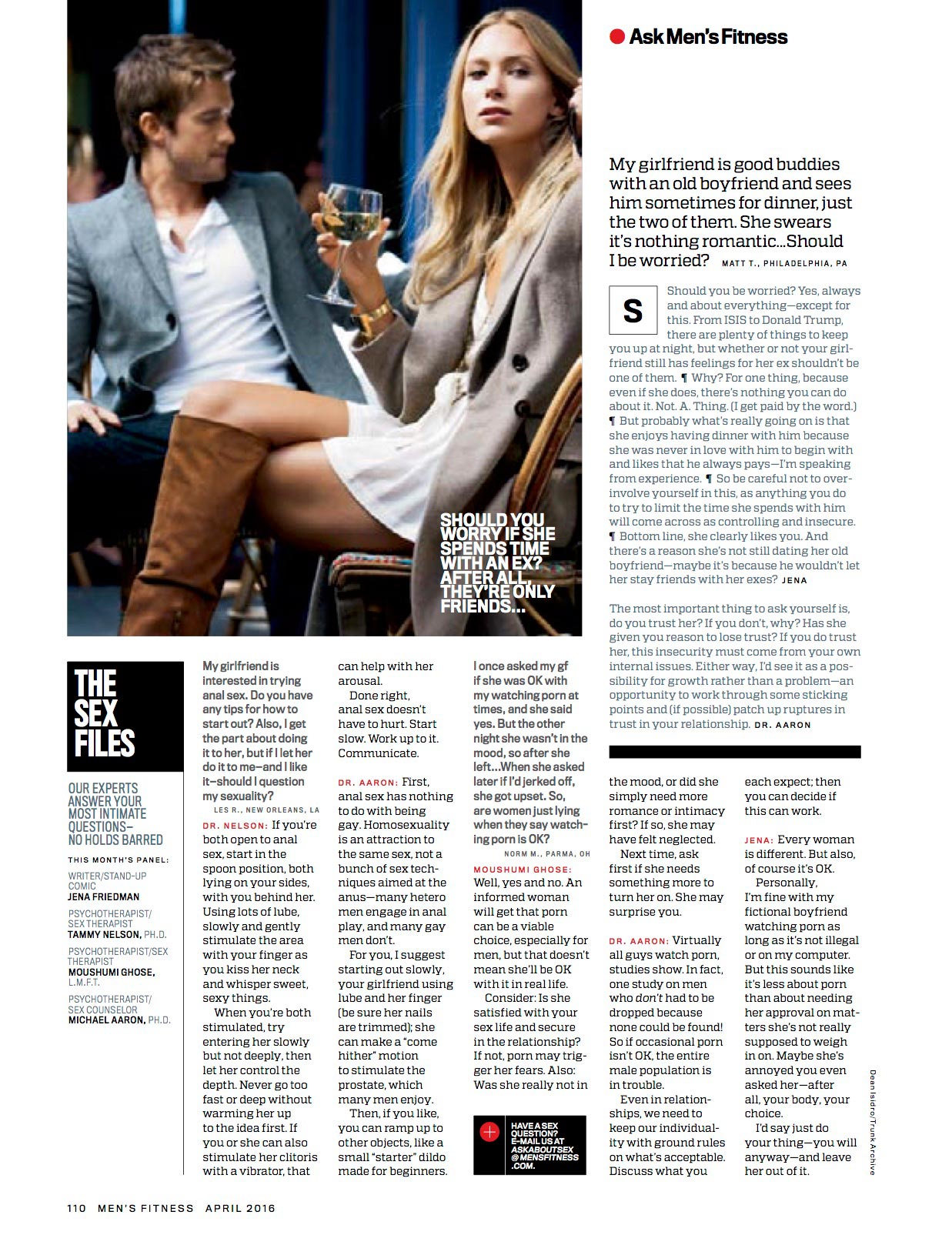
 I was asked by Women's Health Magazine to provide some advise on how to incorporate some new positions to spice up one's sex life. With a bunch of pictures and diagrams, I'm sure you'll find something that will intrigue you.
I was asked by Women's Health Magazine to provide some advise on how to incorporate some new positions to spice up one's sex life. With a bunch of pictures and diagrams, I'm sure you'll find something that will intrigue you.
 Looks like Yahoo News picked up the Reuters article on women's fears that their partners expect sexual perfectionism. Check it out.
Looks like Yahoo News picked up the Reuters article on women's fears that their partners expect sexual perfectionism. Check it out.
 My latest interview with Reuters, this time about social pressure on women to be perfect sexually. "Our society is filled with sexual myths and misconceptions, mostly stemming from a combination of our culture's puritanical roots, as well as rampant consumerism, which feeds off individual insecurities to sell unnecessary products," Aaron said.
My latest interview with Reuters, this time about social pressure on women to be perfect sexually. "Our society is filled with sexual myths and misconceptions, mostly stemming from a combination of our culture's puritanical roots, as well as rampant consumerism, which feeds off individual insecurities to sell unnecessary products," Aaron said.
 Head out to the newsstands and grab a copy of the Jan 2016 issue of Men's Fitness Magazine to see the premier of the new monthly "Sex Files" column in which I answer readers' sex questions. In this month's issue I answer a question in which a guy is looking to help his girlfriend enjoy more pleasure when she is having sex on top. Check out the screenshot below to see my response:
Head out to the newsstands and grab a copy of the Jan 2016 issue of Men's Fitness Magazine to see the premier of the new monthly "Sex Files" column in which I answer readers' sex questions. In this month's issue I answer a question in which a guy is looking to help his girlfriend enjoy more pleasure when she is having sex on top. Check out the screenshot below to see my response:
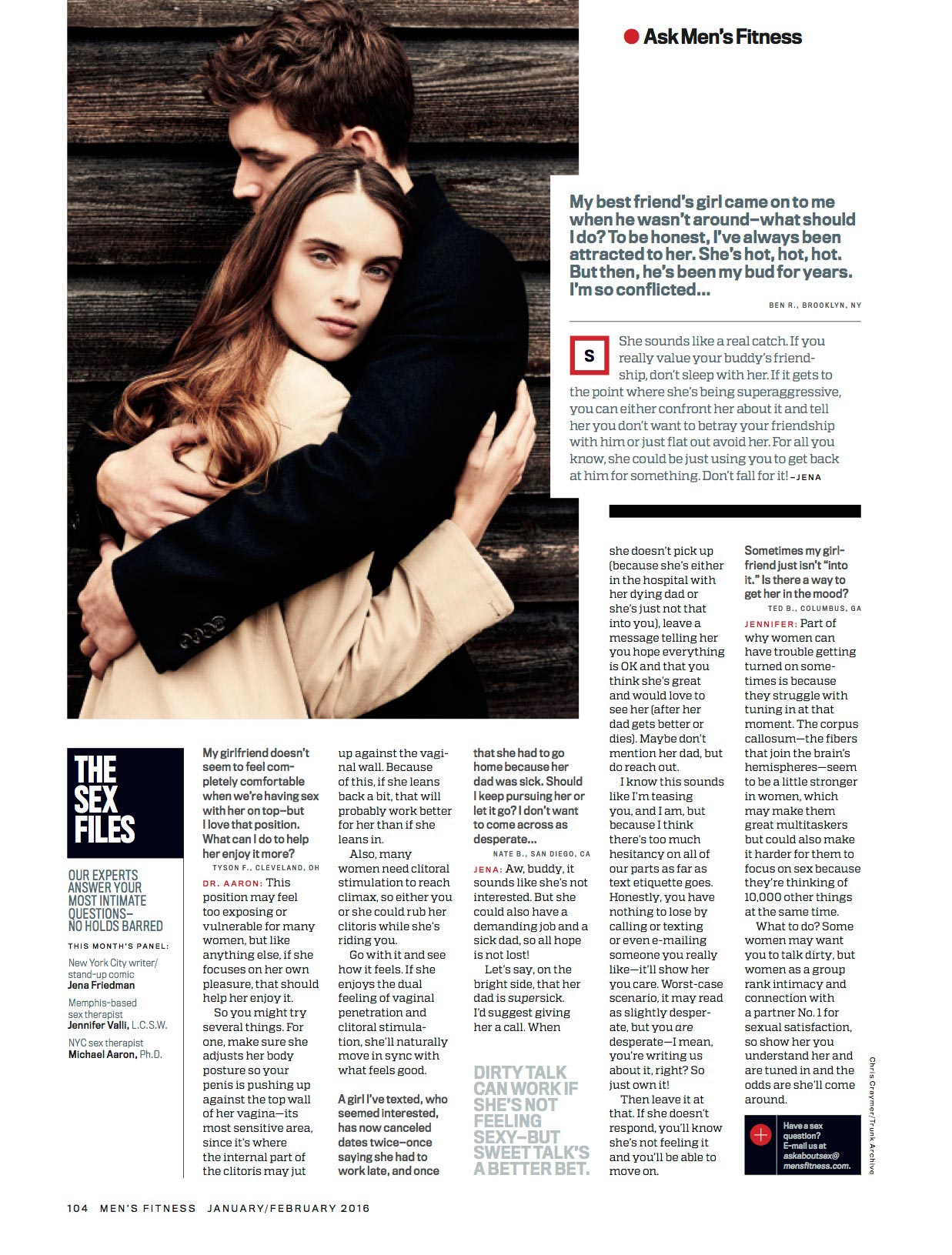
 Love& is a new magazine about relationships and sex. They interviewed me about common things that women may want their guys to improve upon in the bedroom. One of the big ones is touch, as a lot of men are way too rough and don't know how to adjust their touch to what their partner wants. For more on this, and other pointers, check out the article itself below:
Love& is a new magazine about relationships and sex. They interviewed me about common things that women may want their guys to improve upon in the bedroom. One of the big ones is touch, as a lot of men are way too rough and don't know how to adjust their touch to what their partner wants. For more on this, and other pointers, check out the article itself below:
 Market analysts predict that new virtual reality technology will revolutionize the way we experience media, and will specifically boost the porn industry to unprecedented levels. This detailed article covers a lot of ground, addressing both the technology, business and social ramifications of virtual reality porn. I was asked to give my take on the issue and somehow a 20 minute phone conversation was distilled to a brief paragraph at the end of the piece, but nonetheless, it is still a worthwhile read.
Market analysts predict that new virtual reality technology will revolutionize the way we experience media, and will specifically boost the porn industry to unprecedented levels. This detailed article covers a lot of ground, addressing both the technology, business and social ramifications of virtual reality porn. I was asked to give my take on the issue and somehow a 20 minute phone conversation was distilled to a brief paragraph at the end of the piece, but nonetheless, it is still a worthwhile read.
 Does Bill Cosby have a fetish for unconscious women? Who knows? He's not a client and I've never met him, so I cannot say for sure, but this provocative piece in the NY Times tries to get to the bottom of his alleged bizarre behavior. The reporter did a great job dealing with some uncomfortable material, so be sure to click the link below to see what I had to say on this issue:
Does Bill Cosby have a fetish for unconscious women? Who knows? He's not a client and I've never met him, so I cannot say for sure, but this provocative piece in the NY Times tries to get to the bottom of his alleged bizarre behavior. The reporter did a great job dealing with some uncomfortable material, so be sure to click the link below to see what I had to say on this issue:
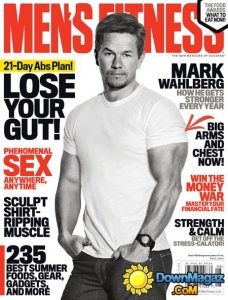 I was recently asked by a reporter from Men's Fitness magazine to discuss reasons why a heterosexual man might refrain from having sex with a willing woman. The questions were basically soft balls, seemingly aimed at a younger, more inexperienced, male audience, but hey, I managed to drop a few decent pointers, relating to finding out if the woman is in a relationship, and if so, what kind of relationship she is in before diving in. If you want to take a look and poke around more, you can go directly to the article below. You are going to have to click to page 3 to see my quotes, btw.
I was recently asked by a reporter from Men's Fitness magazine to discuss reasons why a heterosexual man might refrain from having sex with a willing woman. The questions were basically soft balls, seemingly aimed at a younger, more inexperienced, male audience, but hey, I managed to drop a few decent pointers, relating to finding out if the woman is in a relationship, and if so, what kind of relationship she is in before diving in. If you want to take a look and poke around more, you can go directly to the article below. You are going to have to click to page 3 to see my quotes, btw.
 I was recently interviewed for a Men's Health article on sex toys designed for men. They wanted to know my take on these "robotic masturbators" (as they called them) and as always, I tried to take a fair and balanced view of things. I pointed out that they could be used as a way to get better acquainted with one's sexuality (as well as get some much needed relief), but an over-reliance on technology may also limit guys from developing the necessary skills that would help them form romantic relationships.
At any rate, hurry on over to the article here--
I was recently interviewed for a Men's Health article on sex toys designed for men. They wanted to know my take on these "robotic masturbators" (as they called them) and as always, I tried to take a fair and balanced view of things. I pointed out that they could be used as a way to get better acquainted with one's sexuality (as well as get some much needed relief), but an over-reliance on technology may also limit guys from developing the necessary skills that would help them form romantic relationships.
At any rate, hurry on over to the article here-- 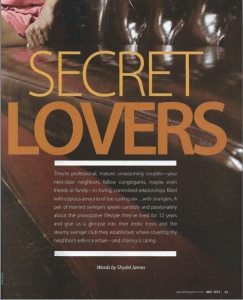 Go check out a great, and I mean GREAT, absolutely fascinating article in the May issue of Upscale Magazine, entitled "Secret Lovers," in which I am interviewed regarding the hush hush world of the swinger subculture. The writer does a really good job of trying to understand the psychology of folks who practice consensual non-monogamy and I think the piece is very even-handed, with some practical tips for couples who are curious about dipping their toes in the lifestyle. I'll leave you with a quote from one of the swingers profiled in the piece, which I think gives a good feel for the tone and depth of the article-- "I love to see her with two guys and two girls at once. I enjoy submissive women, and there is no sexier submission than to watch my wife please me by pleasing others." If that sounds interesting, then I suggest you head out and grab a copy. It's well worth the read.
Go check out a great, and I mean GREAT, absolutely fascinating article in the May issue of Upscale Magazine, entitled "Secret Lovers," in which I am interviewed regarding the hush hush world of the swinger subculture. The writer does a really good job of trying to understand the psychology of folks who practice consensual non-monogamy and I think the piece is very even-handed, with some practical tips for couples who are curious about dipping their toes in the lifestyle. I'll leave you with a quote from one of the swingers profiled in the piece, which I think gives a good feel for the tone and depth of the article-- "I love to see her with two guys and two girls at once. I enjoy submissive women, and there is no sexier submission than to watch my wife please me by pleasing others." If that sounds interesting, then I suggest you head out and grab a copy. It's well worth the read.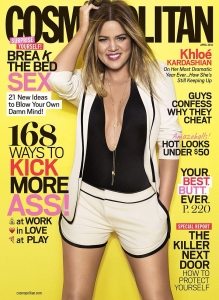 I am featured in the Sex Q&A section of Cosmo's April 2014 issue, in which I get asked about BJs, Plan B, sex in hot tubs, and all kinds of other tittilating reader questions. They did a good job of adding all kinds of humor, including a silly picture of tea bags-- need I say more? It's a can't- miss hoot. Go and check it out at news stands now!
I am featured in the Sex Q&A section of Cosmo's April 2014 issue, in which I get asked about BJs, Plan B, sex in hot tubs, and all kinds of other tittilating reader questions. They did a good job of adding all kinds of humor, including a silly picture of tea bags-- need I say more? It's a can't- miss hoot. Go and check it out at news stands now!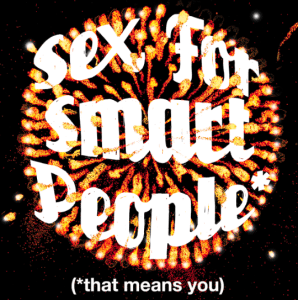 I just recently did an interview for a cool podcast called
I just recently did an interview for a cool podcast called